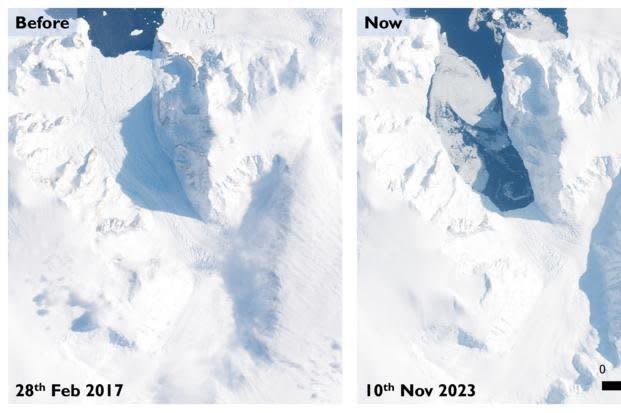Antarctic glacier doubles speed as oceans warm

Nov. 28 (UPI) -- A glacier in the Antarctic is retreating more rapidly than scientists expected, doubling its speed, according to research published Tuesday.
The Cadman Glacier retreated about 5 miles between November 2018 and May 2021 as oceans warmed and the ice shelf thinned, according to research led by Benjamin Wallis, a glaciologist at the University of Leeds. The study was published in the journal Nature.
"We were surprised to see the speed at which Cadman went from being an apparently stable glacier to one where we see sudden deterioration and significant ice loss," Wallis said in a news release.
Wallis and his team tracked the glacier using satellites.
The ice shelf at the end of the Cadman Glacier thinned and collapsed, doubling the speed at which the glacier was flowing and increasing iceberg calving into the sea by 28% in 13 months. The glacier drains around 2.16 billion tons of ice into Beascochea Bay on the west Antarctic peninsula each year.
"What was also curious was that the neighboring glaciers on this part of the west Antarctic Peninsula did not react in the same way, which may hold important lessons for the way we can better project how climate change will continue to affect this important and sensitive polar region.
"Our study brought together data from three decades, nine different satellite missions, and in-situ oceanographic measurements to understand the changes happening in Antarctica," Wallis said. "This demonstrates how important it is to have long-term monitoring of the Earth's polar regions with a range of sensors, which all tell us a different piece of the story."
The Cadman Glacier is losing about 65 feet of elevation a year as ice continues to thin.
Researchers believe the rapid changes were triggered by high ocean temperatures deep in the water column, causing the ice shelf to begin melting from the bottom up. In 2018-19, the ice shelf collapsed.
Since then, the glacier has been in a state of "substantial dynamic imbalance," the researchers said.
Nearby glaciers may have been protected by underwater rock ridges that deflected warmer water away from the Funk and Lever glaciers.
"We have known for some time that the ocean around Antarctica is heating up rapidly, and that this poses a significant threat to glaciers and the ice sheet, with consequences for sea level rise globally," Michael Meredith, from the British Antarctic Survey and one of the authors of the paper, said in the news release.
Ice loss in the region increased after the partial collapse of the Larsen-B ice shelf in 2002. Ice loss from 2007 to 2012 increased by more 400% compared with ice loss from 1992 to 1997.
Studies have shown increasing melt rates beneath Pine Island and Thwaites ice shelves in West Antarctica.
"What this new research shows is that apparently stable glaciers can switch very rapidly, becoming unstable almost without warning, and then thinning and retreating very strongly," Meredith said. "This emphasizes the need for a comprehensive ocean observing network around Antarctica, especially in regions close to glaciers that are especially hard to make measurements."
